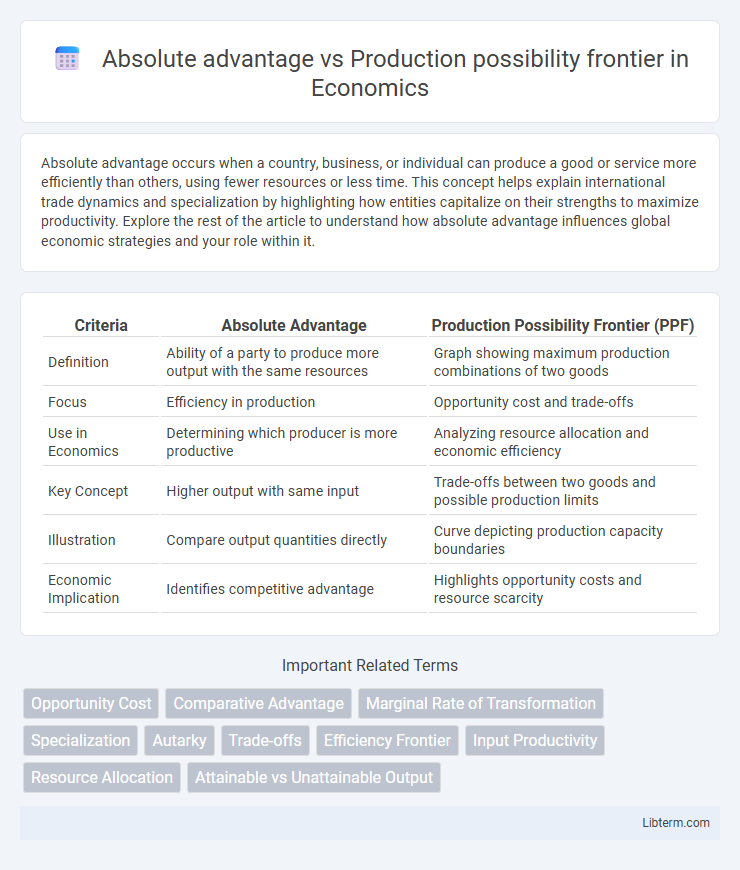Absolute advantage occurs when a country, business, or individual can produce a good or service more efficiently than others, using fewer resources or less time. This concept helps explain international trade dynamics and specialization by highlighting how entities capitalize on their strengths to maximize productivity. Explore the rest of the article to understand how absolute advantage influences global economic strategies and your role within it.
Table of Comparison
| Criteria | Absolute Advantage | Production Possibility Frontier (PPF) |
|---|---|---|
| Definition | Ability of a party to produce more output with the same resources | Graph showing maximum production combinations of two goods |
| Focus | Efficiency in production | Opportunity cost and trade-offs |
| Use in Economics | Determining which producer is more productive | Analyzing resource allocation and economic efficiency |
| Key Concept | Higher output with same input | Trade-offs between two goods and possible production limits |
| Illustration | Compare output quantities directly | Curve depicting production capacity boundaries |
| Economic Implication | Identifies competitive advantage | Highlights opportunity costs and resource scarcity |
Introduction to Absolute Advantage and PPF
Absolute advantage refers to a country's ability to produce a good more efficiently than another country, using fewer resources or producing more output. The Production Possibility Frontier (PPF) illustrates the maximum combinations of two goods that an economy can produce given its resources and technology, highlighting opportunity costs and trade-offs. Understanding absolute advantage helps explain why countries specialize, while the PPF provides a graphical representation of production efficiency and potential economic growth.
Defining Absolute Advantage
Absolute advantage refers to the ability of a country or individual to produce a good or service more efficiently than others, using fewer resources or less time. It contrasts with the production possibility frontier (PPF), which illustrates the maximum output combinations of two goods an economy can achieve given its resource constraints. While absolute advantage highlights superior production capability in absolute terms, the PPF emphasizes opportunity costs and trade-offs in resource allocation.
Understanding the Production Possibility Frontier (PPF)
The Production Possibility Frontier (PPF) illustrates the maximum combinations of two goods that an economy can produce given fixed resources and technology, highlighting opportunity costs and efficient resource allocation. Unlike absolute advantage, which compares productivity between producers, the PPF focuses on trade-offs and the limits of production capacity within an economy. Understanding the PPF helps identify points of efficient production, underutilization, and potential economic growth by shifting the frontier outward.
Key Differences Between Absolute Advantage and PPF
Absolute advantage measures a country's ability to produce a good using fewer resources compared to another country, emphasizing efficiency in production. The Production Possibility Frontier (PPF) illustrates the maximum feasible output combinations of two goods given fixed resources, highlighting opportunity costs and trade-offs. While absolute advantage focuses on productivity, the PPF demonstrates the limits of production and potential gains from specialization and trade.
Economic Implications of Absolute Advantage
Absolute advantage occurs when a country can produce a good more efficiently than another, leading to increased overall productivity and potential for higher economic growth. This efficiency allows nations to specialize in goods where they hold an absolute advantage, improving resource allocation and maximizing output within the limits defined by the production possibility frontier (PPF). Understanding absolute advantage helps countries optimize trade decisions, expanding consumption possibilities beyond their PPF constraints through specialization and exchange.
The Role of PPF in Resource Allocation
The Production Possibility Frontier (PPF) illustrates the maximum output combinations of two goods an economy can achieve using available resources efficiently. Unlike absolute advantage, which compares productivity between entities, the PPF emphasizes how resource allocation decisions impact opportunity costs and the trade-offs faced by an economy. Efficient resource allocation occurs when production points lie on the PPF curve, reflecting optimal use of scarce resources to maximize output.
Absolute Advantage in International Trade
Absolute advantage in international trade refers to a country's ability to produce a good more efficiently than another nation, using fewer resources or less time. This concept drives specialization, enabling countries to maximize output and trade benefits by focusing on goods where they hold an absolute production efficiency edge. Understanding absolute advantage contrasts with the production possibility frontier, which illustrates potential production trade-offs but does not specifically indicate superior efficiency in producing particular goods.
Limitations of Absolute Advantage and PPF
Absolute advantage highlights the ability of a country to produce goods more efficiently than others but fails to account for opportunity costs or resource constraints, limiting its practical application in trade decisions. The Production Possibility Frontier (PPF) illustrates trade-offs and opportunity costs, showing the maximum output combinations given finite resources, but it assumes full employment and fixed technology, which may not reflect dynamic economic conditions. Both models simplify real-world complexities, making them less effective in predicting outcomes when factors like technological change or scale economies are involved.
Real-World Examples of Absolute Advantage and PPF
Absolute advantage occurs when a country can produce a good more efficiently than another, such as Saudi Arabia's dominance in oil extraction due to vast reserves and low production costs. The production possibility frontier (PPF) illustrates the maximum output combinations of two goods, often demonstrated by the United States balancing aircraft and agricultural production on its PPF curve. Real-world examples highlight that while China has an absolute advantage in manufacturing electronics, the PPF shows trade-offs when reallocating resources between consumer goods and technology sectors.
Conclusion: Integrating Absolute Advantage and Production Possibility Frontier
Integrating absolute advantage with the production possibility frontier (PPF) enhances understanding of efficient resource allocation and trade-offs in production. Absolute advantage identifies which entity produces goods more efficiently, while the PPF illustrates the maximum output combinations attainable with given resources. Combining both concepts enables more strategic decision-making by highlighting optimal production points and potential gains from specialization and trade.
Absolute advantage Infographic

 libterm.com
libterm.com